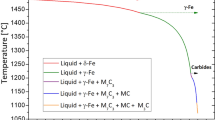Abstract
Microstructure evolution during hot working of Nb-10Hf-1Ti (C-103) alloy has been studied at various temperatures (1273–1473 K) and strain rates (0.01–10 s−1) using a Gleeble™ thermo-mechanical simulator. Flow behavior of the material has been analyzed, processing maps were generated and correlated with the microstructures. Flow stress variation with increasing temperature and decreasing strain rate has been very minimal except in the higher temperature and lower strain rate regime. Enrichment of Hf, C and N was observed at the second phase particle- grain boundary interface in samples deformed at lower strain rate and high temperature. Presence of Hf(C,N) was confirmed through SEM–EDS and these second phase particles may result in high resistance to deformation at this regime depending on their size and distribution. Lower temperature working in combination with static recrystallization or higher temperature working with inherent dynamic recrystallization can be employed for deformation. Strain rate of 0.1–0.01 s−1 and temperature range of 1373–1473 K is identified as a safe working zone for this alloy under a protective atmosphere.









Similar content being viewed by others
Code availability
The code used for development of processing maps is written in MATLAB and is available with one of the co-authors.
References
Anilkumar V, Gupta RK, Narayana Murty SVS, Prasad AD (2016) Hot workability and microstructure control in Co20Cr15W10Ni cobalt-based superalloy. J Alloys Compds 676:527–541
Behra AN, Chaudhuri A, Kapoor R, Chakravartty JK, Suwas S (2016) High temperature deformation behavior of Nb–1 wt.% Zr alloy. Mater Des 92:750–759
Behera AN, Kapoor R, Sarkar A, Chakravartty JK (2014) Hot deformation behaviour of niobium in temperature range 700–1500 °C. Mater Sci Tech 30:637–644
Favre J, Koizumi Y, Chiba A, Fabregue D, Maire E (2013) Deformation behavior and dynamic recrystallization of biomedical Co-Cr-W-Ni (L-605) alloy. Metal Mater Trans A 44:2819–2829
Frank RG (1968) Recent advances in Nb alloys, refractory metal alloys. Plenum Press, New York, pp 325–365
Guo XP, Gao LM, Guan P, Kusabiraki K, Heng Zhi Fu (2017) Microstructure and mechanical properties of an advanced niobium based ultrahigh temperature alloy. Mater Sci Forum 539–543:3690–3695
Gupta RK, Anil Kumar V, Karthikeyan MK, Ramkumar P, Ramesh Narayanan P, Sinha PP (2010) Investigation of cracks generated in columbium alloy (C-103) sheets during deep drawing operation. J Fail Analysis Prevent 10–3:228–232
Gupta RK, Narayana Murty SVS, Pant B, Agarwala V, Sinha PP (2012) Hot workability of γ+ α2 titanium aluminide: Development of processing map and constitutive equations. Mater Sci Eng A 551:169–186
Ji GL, Li FG, Li QH, Li HQ, Li Z (2011) A comparative study on Arrhenius-type constitutive model and artificial neural network model to predict high-temperature deformation behaviour in Aermet100 steel. Mater Sci Eng A 528:4774–4782
Kapoor R, Behera AN, Sarkar A, Chakravartty JK (2014) Hot deformation behaviour of niobium in temperature range 700–1500 °C. Mater Sci Tech 30:637–644
Klein MJ, Gulden ME (1973) The activation energy for creep of columbium (Niobium). Met Mater Trans A 4:2175–2180
Miura S, Murasato Y, Sekito Y, Tsutsumi Y, Ohkubo K, Kimura Y, Mishima Y, Mohri T (2009) Effect of microstructure on the high-temperature deformation behavior of Nb–Si alloys. Mater Sci Eng A 510–511:317–321
Narayana Murty SVS, Sarma M, Nageswara Rao B (1997) On the evaluation of efficiency parameters in processing maps. Met Mater Trans A 28:1581–1582
Narayana Murty SVS, Nageswara Rao B (1998) On the development of instability criteria during hot working with reference to IN 718. Mater Sci Eng A 254:76–82
Narayana Murty SVS, Nageswara Rao B, Kashyap BP (2000) Instability criteria for hot deformation of materials. Int Mater Rev 45:15–26
Nasser SN, Guo W (2000) Flow stress of commercially pure niobium over a broad range of temperatures and strain rates. Mater Sci Eng A 284:202–210
Panwar SS, Prasad K, Patro TU, Balasubramanian K, Venkataraman B (2015) On the occurrence of dynamic strain aging in C-103 Nb based alloy. Mater Sci Eng A 620:286–292
Philips NR, Carl M, Cunningham NJ (2020) new opportunities in refractory alloys. Met Mater Trans A 51:3299–3310
Prasad YVRK, Gegel HL, Doraive-Lu SM, Malas JC, Morgan JT, Lark KA, Barker DR (1984) Modeling of dynamic material behavior in hot deformation: forging of Ti-6242. Met Mater Trans A 15:1883–1892
Prasad YVRK, Seshacharyulu T (1998) Modelling of hot deformation for microstructural control. Int Mater Rev 43:243–258
Sarkar A, Kapoor R, Verma A, Chakravartty JK, Suri AK (2012) Hot deformation behavior of Nb–1Zr–0.1C alloy in the temperature range 700–1700 °C. J Nuc Mater 422:1–7
Sheftel EN, Bannykh OA (1994) Niobium—base alloys. Int J Refractory Hard Mater 12:303–314
Ziegler H (1963) In “Progress in Solid Mechanics,” vol 4. Wiley, New York, p 93
Zuyok VA, Krasnorutskyy VS, Chernyayeva TP, Tretyakov MV, Rud RO (2020) Influence of structure of hafnium rods on their mechanical properties, corrosion and radiation resistances. Prog Phy Met 21–1:46–71
Acknowledgements
The authors are thankful to DD, MME for valuable suggestions during this work and Director, VSSC for granting permission to publish this work. The authors are also thankful to MCD, VSSC and HWMD, VSSC for microscopy support; SAIL-RDCIS, Ranchi for Gleeble facility support and National facility for Texture and OIM, IIT Bombay for EBSD support.
Funding
This work did not receive any funding from any external funding agency.
Author information
Authors and Affiliations
Corresponding author
Ethics declarations
Conflict of interest
The authors do not have any conflict/ competing interests with anyone/ any groups.
Availability of data and material
The data are a part of continuing research and hence cannot be shared at this point of time.
Additional information
Publisher's Note
Springer Nature remains neutral with regard to jurisdictional claims in published maps and institutional affiliations.
Rights and permissions
About this article
Cite this article
Gupta, R.K., Kumar, V.A., Venkateshwaran, T. et al. Microstructure Evolution during Hot Working of Nb-10Hf-1Ti Refractory Alloy. Trans Indian Natl. Acad. Eng. 6, 111–121 (2021). https://doi.org/10.1007/s41403-020-00194-8
Received:
Accepted:
Published:
Issue Date:
DOI: https://doi.org/10.1007/s41403-020-00194-8




